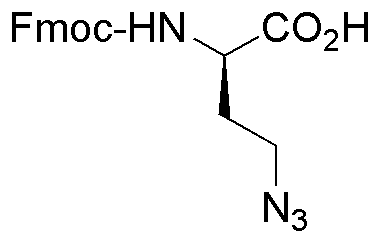Na-Fmoc-Ng-Azido-D-2,4-diaminobutyric acid is widely utilized in research focused on:
- Peptide Synthesis: This compound serves as a crucial building block in the synthesis of peptides, allowing researchers to create complex structures for various applications in drug development.
- Bioconjugation: Its azido group enables efficient bioconjugation reactions, facilitating the attachment of biomolecules to surfaces or other molecules, which is essential in developing targeted therapies.
- Drug Development: The compound's unique structure can lead to the creation of novel therapeutic agents, particularly in oncology, where targeted treatments are increasingly important.
- Research in Chemical Biology: It is used in studies that explore protein interactions and functions, helping scientists understand biological processes at a molecular level.
- Fluorescent Labeling: The Fmoc group allows for easy incorporation into fluorescent labeling techniques, enhancing imaging and tracking of biological molecules in research.
General Information
Properties
Safety and Regulations
Applications
Na-Fmoc-Ng-Azido-D-2,4-diaminobutyric acid is widely utilized in research focused on:
- Peptide Synthesis: This compound serves as a crucial building block in the synthesis of peptides, allowing researchers to create complex structures for various applications in drug development.
- Bioconjugation: Its azido group enables efficient bioconjugation reactions, facilitating the attachment of biomolecules to surfaces or other molecules, which is essential in developing targeted therapies.
- Drug Development: The compound's unique structure can lead to the creation of novel therapeutic agents, particularly in oncology, where targeted treatments are increasingly important.
- Research in Chemical Biology: It is used in studies that explore protein interactions and functions, helping scientists understand biological processes at a molecular level.
- Fluorescent Labeling: The Fmoc group allows for easy incorporation into fluorescent labeling techniques, enhancing imaging and tracking of biological molecules in research.
Documents
Safety Data Sheets (SDS)
The SDS provides comprehensive safety information on handling, storage, and disposal of the product.
Product Specification (PS)
The PS provides a comprehensive breakdown of the product’s properties, including chemical composition, physical state, purity, and storage requirements. It also details acceptable quality ranges and the product's intended applications.
Certificates of Analysis (COA)
Search for Certificates of Analysis (COA) by entering the products Lot Number. Lot and Batch Numbers can be found on a product’s label following the words ‘Lot’ or ‘Batch’.
Número de catálogo
Número de lote/lote
Certificates Of Origin (COO)
This COO confirms the country where the product was manufactured, and also details the materials and components used in it and whether it is derived from natural, synthetic, or other specific sources. This certificate may be required for customs, trade, and regulatory compliance.
Número de catálogo
Número de lote/lote
Safety Data Sheets (SDS)
The SDS provides comprehensive safety information on handling, storage, and disposal of the product.
DownloadProduct Specification (PS)
The PS provides a comprehensive breakdown of the product’s properties, including chemical composition, physical state, purity, and storage requirements. It also details acceptable quality ranges and the product's intended applications.
DownloadCertificates of Analysis (COA)
Search for Certificates of Analysis (COA) by entering the products Lot Number. Lot and Batch Numbers can be found on a product’s label following the words ‘Lot’ or ‘Batch’.
Número de catálogo
Número de lote/lote
Certificates Of Origin (COO)
This COO confirms the country where the product was manufactured, and also details the materials and components used in it and whether it is derived from natural, synthetic, or other specific sources. This certificate may be required for customs, trade, and regulatory compliance.


